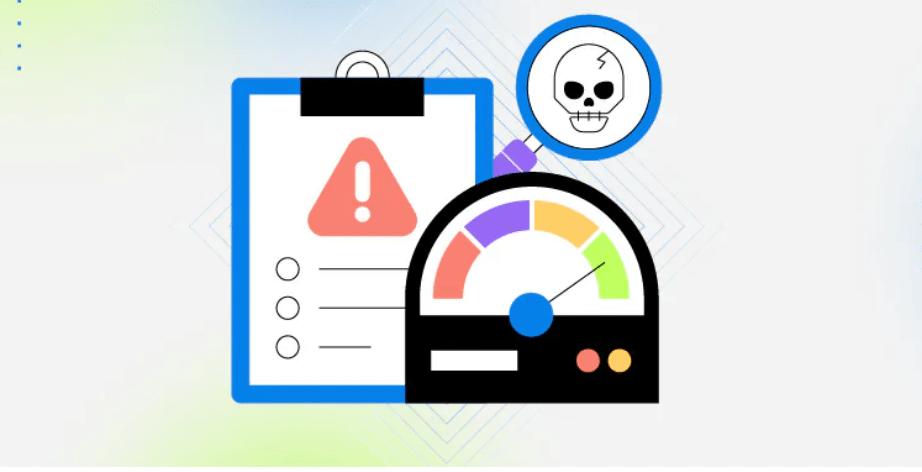Are you managing a complex project and worried about potential risks? The fact is, every project carries some level of risk.
This article will guide you through the ins and outs of a Risk Register, an essential tool for foreseeing these risks and plotting your path forward.
Key Takeaways
- A risk register is a tool used in project management to identify and manage potential risks throughout a project or business operation.
- It helps project managers keep track of possible problems, assess their likelihood and impact, and develop strategies to prevent or minimize them.
- The components of a risk register include risk identification, description, category, likelihood, analysis, and mitigation measures.
- By using a risk register, project managers can improve risk management, make better decisions, and ensure the early identification of potential risks.
Definition of a Risk Register

A risk register is a key tool in risk management that helps organizations identify, analyze, and manage potential risks throughout a project or business operation.
Purpose of a risk register
A risk register gives you a way to keep track of possible problems. It helps you stay ready if things go wrong in a project. The risk register lets you write down all the problems that could come up.
This list also tells you how big each problem might be and what steps can stop them from happening. Not just any problem is put here, only those that matter for your project. This tool makes sure you catch issues before they grow too big to manage, helping save time and money.
It’s important to always keep this document updated throughout your entire project life cycle.
Differences between a risk register and a risk matrix
Although both tools are valuable in risk management, a risk register and a risk matrix have distinct functions and structures.
| Risk Register | Risk Matrix | |
|---|---|---|
| Purpose | To document, track, and monitor potential risks and take appropriate measures to prevent or correct them. | To visually represent the probability and impact of identified risks, aiding in prioritization and decision-making. |
| Structure | Can be displayed as a table or a scatterplot, capturing a wide range of information about each identified risk. | Usually presented as a grid with likelihood on one axis and impact on the other, helping to visually identify high-priority risks. |
| Components | Contains risk identification, description, category, likelihood, analysis, and mitigation measures. | Consists only of risk likelihood and impact. |
| Regularity of Updates | Should be updated and reviewed regularly throughout the project lifecycle. | Usually updated periodically or when significant changes occur in the risk environment. |
| Project Management Role | Serves as the first step in managing risks effectively. | Aids in risk evaluation and forms the basis for risk response strategies. |
While both the risk register and risk matrix serve essential functions in risk management, they fulfill different roles and deliver unique value in a project, contributing to its overall success.
Components of a Risk Register

The components of a risk register include risk identification, risk description, risk category, risk likelihood, risk analysis, and risk mitigation.
Risk identification
First, you spot the risks. This is called risk identification. It means seeing what may bring trouble or harm later on. A neat tool to help with this is a risk register. It makes note of all possible dangers in a project.
You don’t want any nasty surprises, right? So, start digging into each part of your plan to uncover threats that hide there before they grow big and cause issues!
Risk description
A risk description is a clear and concise explanation of a potential risk that could impact a project or organization. It provides details about the nature, severity, and implications of the risk.
In a risk register, each identified risk is described in terms of its potential consequences and likelihood of occurrence. This helps stakeholders understand the specific risks they may face and allows for better decision-making when it comes to developing mitigation strategies and response plans.
By accurately describing risks, project managers can ensure that everyone involved has a comprehensive understanding of the potential challenges ahead.
Risk category
A risk category in a risk register is a way to group and classify different types of risks. It helps project managers and specialists understand the nature of the risks they are dealing with and prioritize them accordingly.
By categorizing risks, it becomes easier to identify patterns, assess their likelihood and impact, and develop appropriate response plans. Examples of risk categories may include technical risks, operational risks, financial risks, or regulatory compliance risks.
Each category represents a distinct area of concern that needs to be addressed in order to ensure the successful completion of a project. Having clear risk categories in a risk register allows for better organization and management of potential issues throughout the project lifecycle.
Risk likelihood
The risk likelihood refers to the chance or probability of a risk event occurring. It helps project managers and specialists understand how likely it is for a particular risk to happen during a project.
By assessing the risk likelihood, they can prioritize risks and allocate resources accordingly. The risk register includes information about the likelihood of each identified risk, which allows project managers to develop appropriate response plans and mitigation measures.
Regularly reviewing and updating the risk register throughout the project lifecycle ensures that potential risks are monitored effectively and addressed proactively.
Risk analysis
Risk analysis is a crucial step in managing potential risks. It involves assessing the likelihood and impact of each risk identified in the risk register. This helps project managers understand which risks are more significant and require immediate attention.
During risk analysis, project teams evaluate the probability of each risk occurring and determine its potential consequences on the project. By analyzing risks, project managers can make informed decisions about how to allocate resources, develop appropriate response plans, and prioritize mitigation measures.
Regularly reviewing and updating the risk analysis ensures that projects stay on track and minimize any negative impacts caused by unforeseen events or issues.
Risk mitigation
Risk mitigation is a crucial aspect of project management. It involves taking proactive measures to reduce the likelihood or impact of potential risks identified in the risk register.
By implementing mitigation strategies, project managers can minimize the chances of risks occurring and their negative consequences. This could include actions like strengthening security protocols, creating backup plans, implementing redundancy measures, or training team members on best practices.
The goal is to prevent or minimize the impact of risks on the project’s success. Regularly reviewing and updating the risk register allows project managers to assess whether their mitigation efforts are effective and make any necessary adjustments along the way.
Benefits of Using a Risk Register

Using a risk register has various benefits, including early identification of potential risks, improved risk management, and better decision making.
Early identification of potential risks
Early identification of potential risks is a crucial step in project management. By identifying risks at an early stage, project managers can take proactive measures to prevent or minimize their impact on the project.
The risk register serves as a tool to document and track these potential risks, allowing project teams to analyze and prioritize them based on their likelihood and severity. This allows for the development of effective risk mitigation strategies and ensures that resources are allocated appropriately.
Regularly reviewing and updating the risk register throughout the project lifecycle helps to ensure that new risks are identified and addressed promptly, contributing to better project outcomes.
Improved risk management
Having a risk register can greatly improve risk management in technology projects. By documenting and tracking potential risks, project managers can identify and assess them more effectively.
They can then develop appropriate response plans and allocate resources accordingly. This proactive approach allows for early identification and mitigation of risks, reducing their impact on the project’s success.
Regularly updating and reviewing the risk register throughout the project lifecycle ensures that risks are continuously monitored and managed, increasing the overall effectiveness of risk management efforts.
Better decision making
By using a risk register, project managers can make better decisions when it comes to managing risks. The risk register helps them identify and prioritize potential risks, analyze their likelihood and impact, and develop appropriate response plans.
With all the necessary information documented in one place, project managers can assess the potential consequences of different options and choose the best course of action to minimize risk and increase the chances of project success.
Regularly updating and reviewing the risk register ensures that decision making remains informed throughout the entire project lifecycle.
Creating a Risk Register

To create a risk register, follow the steps involved in identifying and analyzing risks, and use effective tips for creating an efficient risk register. Read on to learn more!
Steps involved
To create a risk register, follow these steps:
- Identify potential risks for the project.
- Describe each risk in detail, including its nature and potential impact.
- Categorize the risks based on their type (e.g., technical, financial, operational).
- Determine the likelihood of each risk occurring and assess its potential impact.
- Analyze the risks to prioritize them based on their severity and likelihood.
- Develop mitigation measures or response plans for each identified risk.
- Monitor and evaluate the risks throughout the project lifecycle.
- Implement control measures to minimize the likelihood or impact of each risk.
- Regularly update and review the risk register to ensure its relevance.
- Communicate and report on the risks to stakeholders regularly.
Tips for effective risk register creation
To create an effective risk register, consider the following tips:
- Clearly define the scope and objectives of your project to help identify relevant risks.
- Involve key stakeholders and subject matter experts in the risk identification process.
- Use a standardized risk categorization framework to ensure consistency.
- Prioritize risks based on their potential impact and likelihood of occurring.
- Assign owners to each identified risk who will be responsible for its management.
- Document detailed descriptions of each risk, including its potential consequences.
- Include mitigation measures for each identified risk, outlining how they will be addressed or avoided.
- Regularly review and update the risk register throughout the project lifecycle.
- Ensure that your risk register is easily accessible to all project team members and stakeholders.
- Continuously monitor and reassess risks as new information becomes available.
Conclusion
In conclusion, a risk register is a valuable tool in project management that helps identify and manage potential risks. By documenting and tracking risks, project managers can make informed decisions and take proactive measures to mitigate their impact.
It is an essential component of successful risk management and contributes to the overall success of a project.
Frequently Asked Questions
What is a risk register?
A risk register is a document or tool used to identify and record potential risks that could affect a project, business, or organization.
Why is a risk register important?
A risk register is important because it helps organizations anticipate and plan for potential risks, allowing them to be more prepared and proactive in managing those risks.
How do you create a risk register?
To create a risk register, you list down the identified risks along with their descriptions, likelihood of occurrence, impact on the project or organization, and proposed actions to address them.
Who should use a risk register?
A risk register can be used by project managers, business owners, or anyone responsible for overseeing projects or operations within an organization.
Can I update the risk register as new risks arise?
Yes, it’s important to regularly review and update the risk register as new risks are identified or existing ones change in probability or impact. This helps ensure that all potential risks are properly managed throughout the life of the project or operation.



